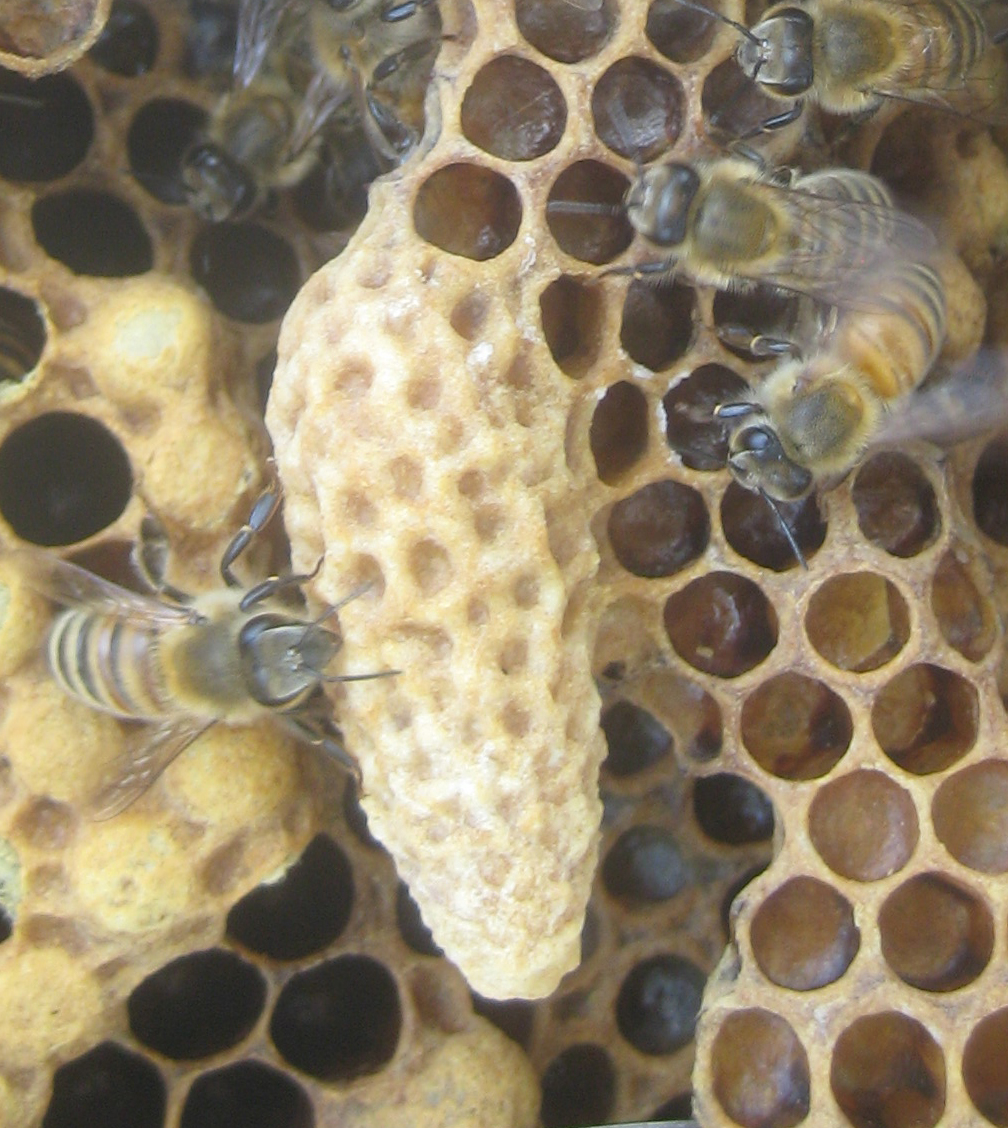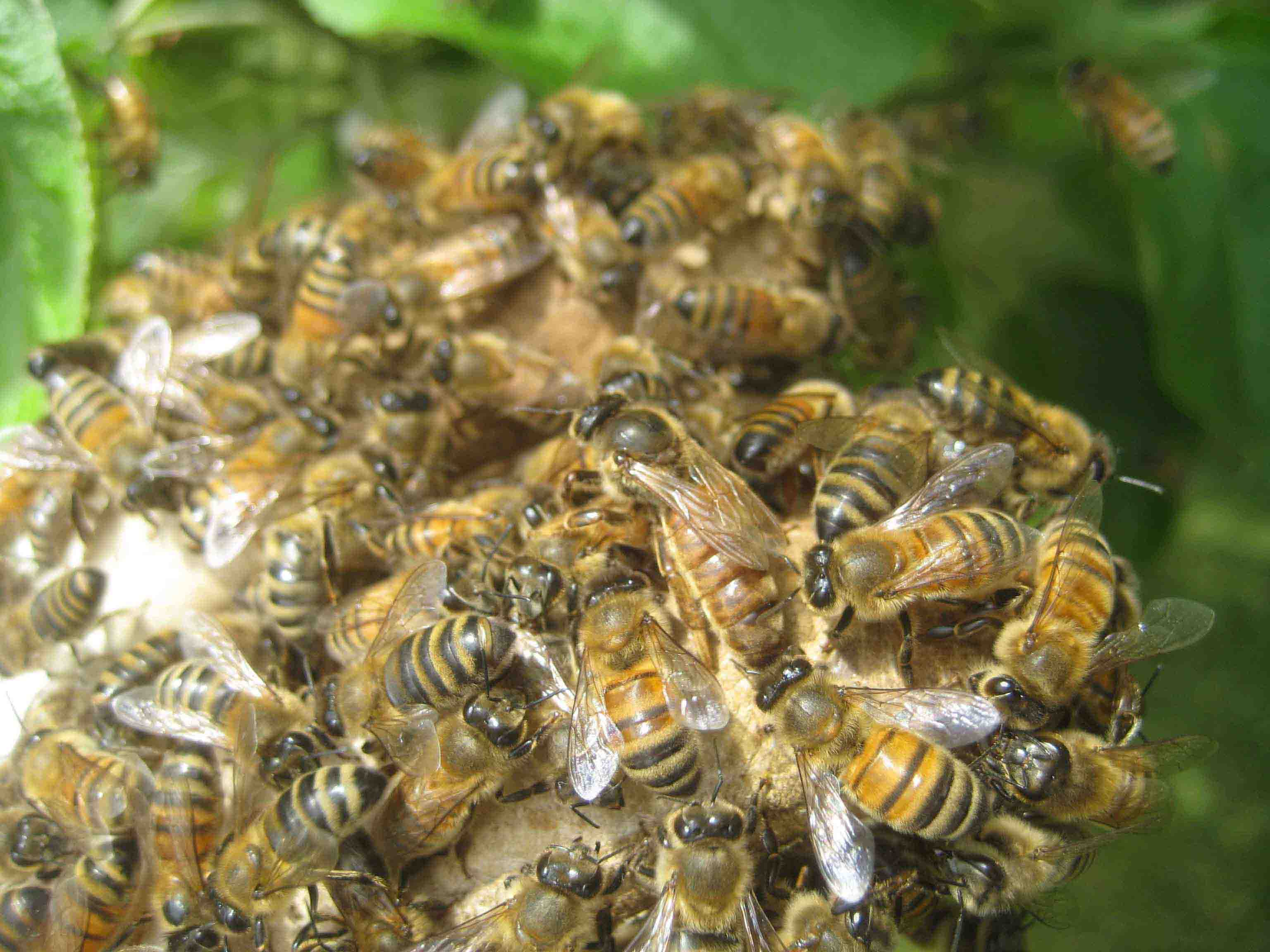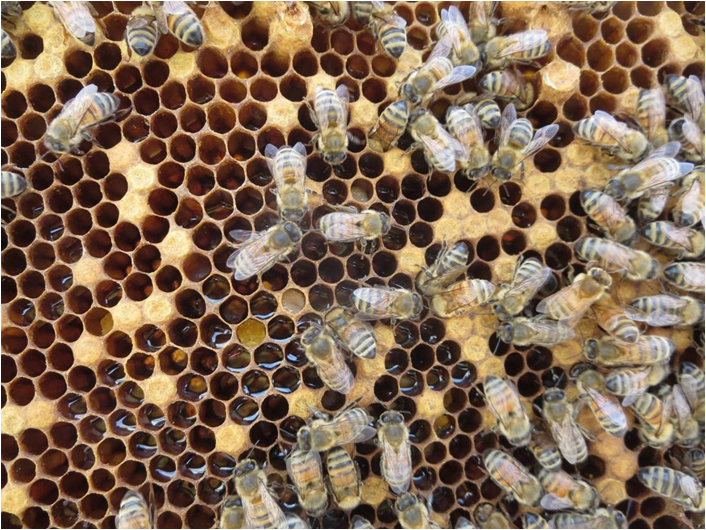A honeybee colony is like a sea anemone. Each bee is like a cell within a larger organism, some moving food, some removing waste, and some making stings. And when the organism wants to reproduce it splits in two, like the binary fission of a sea anemone.
 Individual honeybees hatch from eggs laid by the mother queen. When their numbers have grown so many that they begin to feel crowded in their hive, the worker bees create larger chambers, called swarm cells, for the mother queen to lay eggs in. When the infant queens reach the pupa stage, their cells are capped with wax to protect the metamorphosis occurring within. The colony swarms soon after.
Individual honeybees hatch from eggs laid by the mother queen. When their numbers have grown so many that they begin to feel crowded in their hive, the worker bees create larger chambers, called swarm cells, for the mother queen to lay eggs in. When the infant queens reach the pupa stage, their cells are capped with wax to protect the metamorphosis occurring within. The colony swarms soon after.
 There may have been some confusion in Ancient Greece about the source of honeybee swarms. Around 8 AD, the Roman poet Ovid recorded the Greek story of Aristaeus, the first beekeeper and son of Apollo. Aristaeus’ bees had died and he was wailing over his loss. His mother, Cyrene, sent him to find the prophet Proteus, to learn how to obtain fresh swarms. Proteus told Aristaeus to bury the carcass of a slaughtered ox. As the ox decayed, swarms of bees would fly from it. “The death of one thus produced a thousand lives.” Perhaps the Greeks were just fucking with Ovid, because people of that time clearly understood how colonies reproduced: The Roman, Marcus Varro, (116 BC – 27 BC), wrote “The time when the bees are ready to swarm … generally occurs when the well hatched new brood is over large. … When they are getting ready to fly out or even have begun the flight, they make a loud humming sound exactly as soldiers do when they are breaking camp.”
There may have been some confusion in Ancient Greece about the source of honeybee swarms. Around 8 AD, the Roman poet Ovid recorded the Greek story of Aristaeus, the first beekeeper and son of Apollo. Aristaeus’ bees had died and he was wailing over his loss. His mother, Cyrene, sent him to find the prophet Proteus, to learn how to obtain fresh swarms. Proteus told Aristaeus to bury the carcass of a slaughtered ox. As the ox decayed, swarms of bees would fly from it. “The death of one thus produced a thousand lives.” Perhaps the Greeks were just fucking with Ovid, because people of that time clearly understood how colonies reproduced: The Roman, Marcus Varro, (116 BC – 27 BC), wrote “The time when the bees are ready to swarm … generally occurs when the well hatched new brood is over large. … When they are getting ready to fly out or even have begun the flight, they make a loud humming sound exactly as soldiers do when they are breaking camp.”
 The bees make a roar when they leave the hive, the beating of thousands of wings filling the air with sound. They shoot out of the hive entrance like water from a hose. Outside the confines of their hive, the bees build a cyclone up to fifty feet across and twenty feet deep. This cyclone turns into a cloud that follows the queen to wherever she’s chosen to land. Then the bees pile on top of and around her, creating a cluster that hangs from the spot where she has landed. Once settled, scout bees go in search of a new home. They return to the cluster to recruit other bees to check out potential sites, giving directions in dance moves. Sometimes they fight, head-bumping each other mid-dance to make their point. Eventually the swarm agrees on a site, and as swiftly as they landed they are gone, moving in to their new home.
The bees make a roar when they leave the hive, the beating of thousands of wings filling the air with sound. They shoot out of the hive entrance like water from a hose. Outside the confines of their hive, the bees build a cyclone up to fifty feet across and twenty feet deep. This cyclone turns into a cloud that follows the queen to wherever she’s chosen to land. Then the bees pile on top of and around her, creating a cluster that hangs from the spot where she has landed. Once settled, scout bees go in search of a new home. They return to the cluster to recruit other bees to check out potential sites, giving directions in dance moves. Sometimes they fight, head-bumping each other mid-dance to make their point. Eventually the swarm agrees on a site, and as swiftly as they landed they are gone, moving in to their new home.
That site isn’t always nearby. I followed a swarm for ½ mile last summer, losing it when the road turned and they continued on over the tops of the trees. My friend Bruce caught sight of a swarm leaving a hive on his property a few weeks ago. He followed the bees across a neighbor’s cow pasture, pushing through shoulder-height grass as the swarm sped on to the forest’s edge, about an 1/8th of a mile from the hive. The bees landed 50 feet up an old gnarly cottonwood tree, far out of reach. Sometimes you’ve just got to let a swarm go.
And sometimes swarms get caught in the most unfortunate of ways: A woman at one of my talks described colliding with a swarm on the highway. The bees’ nectar-laden bodies splattered against her windshield and the resulting sticky goo was impossible to wash off with the windshield washer fluid and wiper blades.
In preparation for swarming, departing workers will first gorge themselves on nectar or honey from the hive, to fuel their search for a new home. This is one of the reasons a beekeeper might not want her honeybees to swarm – it reduces the amount of honey in the hive (not to mention the number of bees!). Each bee can hold about 32mg of nectar in her honey crop. A swarm may consist of 30,000 bees. That’s about two pounds of sweet honey, flying through the air.
Though I enjoy catching swarms, I try to manage my colonies so they won’t. I start in early spring by moving the bottom hive boxes to the top of the hives. Over the winter, the colony works its way upward in the hive, leaving the lower boxes empty. After the threat of frost has passed, I move the empty box to the top so that the colony has space to grow. Then I monitor the colony for signs of crowding.
 Crowding can occur from too many bees, or too much nectar. If there is too much nectar I will rearrange frames so that there are empty frames between nectar-filled frames (called “checkerboarding”), and I will add a super to the top of the hive. If there are too many bees I will split the colony into two, removing all the frames of brood and eggs into a separate hive. (Two criteria must be in place for this to work: first, you must find the queen and keep her in the original hive. Second, there must be eggs in the frames of brood, so that the bees in the new hive can raise a new queen.)
Crowding can occur from too many bees, or too much nectar. If there is too much nectar I will rearrange frames so that there are empty frames between nectar-filled frames (called “checkerboarding”), and I will add a super to the top of the hive. If there are too many bees I will split the colony into two, removing all the frames of brood and eggs into a separate hive. (Two criteria must be in place for this to work: first, you must find the queen and keep her in the original hive. Second, there must be eggs in the frames of brood, so that the bees in the new hive can raise a new queen.)
Managing colonies to avoid swarms is labor intensive, but the effort will help keep you in good graces with your neighbors and provides you with additional colonies that you can use to build your apiary.
I’d love to hear your thoughts on swarms and swarm management, especially what tricks you use to keep your girls from swarming. Please share in the comments below: